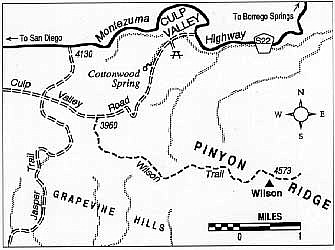 Facebook
Facebook
 X
X
 Instagram
Instagram
 TikTok
TikTok
 Youtube
Youtube
Pinyon Ridge stands just high enough on the Anza-Borrego desert rim -- and therefore gets just enough rain -- to support a sparse growth of pinyon-pine trees. Hiking along this ridge, you get expansive views stretching to the Salton Sea and beyond, framed by picturesque foregrounds of eroded boulders and gnarled pinyons.
Some two decades ago the Wilson Trail, an old jeep road along the crest of the Pinyon Ridge, was closed to motorized travel. That is the route you hike on today -- or at least its remnants, which are of trail width in some places. With an average elevation exceeding 4000 feet, the hike features tolerable temperatures on most days through mid May. Bring plenty of drinking water with you.
To reach the trailhead, turn west on the unpaved Old Culp Valley Road from mile 10.4 on Montezuma Highway (east of Ranchita and west of Borrego Springs). The road becomes progressively more uneven and rutted as you climb, so you may want to stop short of the trailhead if the going gets too rough for your vehicle. At 1.1 miles from Montezuma Highway, a turnout near Cottonwood Spring (easily identified by tall cottonwoods) offers the last easy place to turn around and park if you decide to drive no farther. Whether you decide to drive or walk at this point, go another 1.9 miles to the intersection of the Wilson Trail, on the left. (Anza-Borrego Desert State Park requires that you have a parking permit for day use, which costs $5 daily or $50 annually. For information, call the park at 760-767-4205 or 760-767-5311.)
Wilson Trail's eroded track meanders south and east over and around a series of rocky knolls. Along the way you'll see what biologists call transition-zone vegetation: chamise, sage, mountain mahogany, scrub oak, sugar bush, manzanita, Mojave yucca, buckhorn cholla cactus, juniper, and pinyon pine, to name a few. This mix of high desert and chaparral vegetation exists along a narrow belt between the mountains and the desert floor.
After 4 miles you'll pass north of "Wilson" peak, elevation 4573 feet, the high point on the ridge. This is a good spot for a panoramic view. Scramble up over the rocks, discover a surveyor's benchmark, and take a look around. Palomar Observatory's dome gleams on the dark Palomar ridge to the west. The broad sweep of the Santa Rosa Mountains in the northeast serves as a backdrop for Borrego Valley and Coyote Mountain. Far to the east are the Salton Sea and the Chocolate Mountains of Imperial County. The Vallecito Mountains rise to the southeast; and the Laguna and Cuyamaca Mountains stand to the south and southwest.


Pinyon Ridge stands just high enough on the Anza-Borrego desert rim -- and therefore gets just enough rain -- to support a sparse growth of pinyon-pine trees. Hiking along this ridge, you get expansive views stretching to the Salton Sea and beyond, framed by picturesque foregrounds of eroded boulders and gnarled pinyons.
Some two decades ago the Wilson Trail, an old jeep road along the crest of the Pinyon Ridge, was closed to motorized travel. That is the route you hike on today -- or at least its remnants, which are of trail width in some places. With an average elevation exceeding 4000 feet, the hike features tolerable temperatures on most days through mid May. Bring plenty of drinking water with you.
To reach the trailhead, turn west on the unpaved Old Culp Valley Road from mile 10.4 on Montezuma Highway (east of Ranchita and west of Borrego Springs). The road becomes progressively more uneven and rutted as you climb, so you may want to stop short of the trailhead if the going gets too rough for your vehicle. At 1.1 miles from Montezuma Highway, a turnout near Cottonwood Spring (easily identified by tall cottonwoods) offers the last easy place to turn around and park if you decide to drive no farther. Whether you decide to drive or walk at this point, go another 1.9 miles to the intersection of the Wilson Trail, on the left. (Anza-Borrego Desert State Park requires that you have a parking permit for day use, which costs $5 daily or $50 annually. For information, call the park at 760-767-4205 or 760-767-5311.)
Wilson Trail's eroded track meanders south and east over and around a series of rocky knolls. Along the way you'll see what biologists call transition-zone vegetation: chamise, sage, mountain mahogany, scrub oak, sugar bush, manzanita, Mojave yucca, buckhorn cholla cactus, juniper, and pinyon pine, to name a few. This mix of high desert and chaparral vegetation exists along a narrow belt between the mountains and the desert floor.
After 4 miles you'll pass north of "Wilson" peak, elevation 4573 feet, the high point on the ridge. This is a good spot for a panoramic view. Scramble up over the rocks, discover a surveyor's benchmark, and take a look around. Palomar Observatory's dome gleams on the dark Palomar ridge to the west. The broad sweep of the Santa Rosa Mountains in the northeast serves as a backdrop for Borrego Valley and Coyote Mountain. Far to the east are the Salton Sea and the Chocolate Mountains of Imperial County. The Vallecito Mountains rise to the southeast; and the Laguna and Cuyamaca Mountains stand to the south and southwest.
